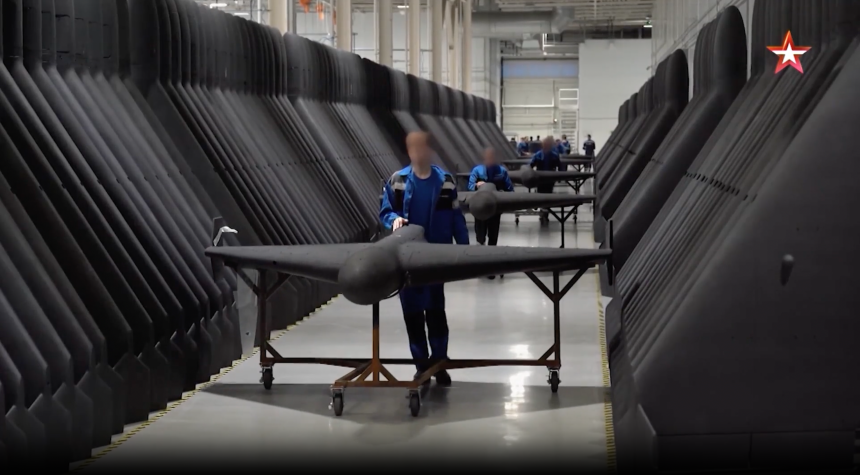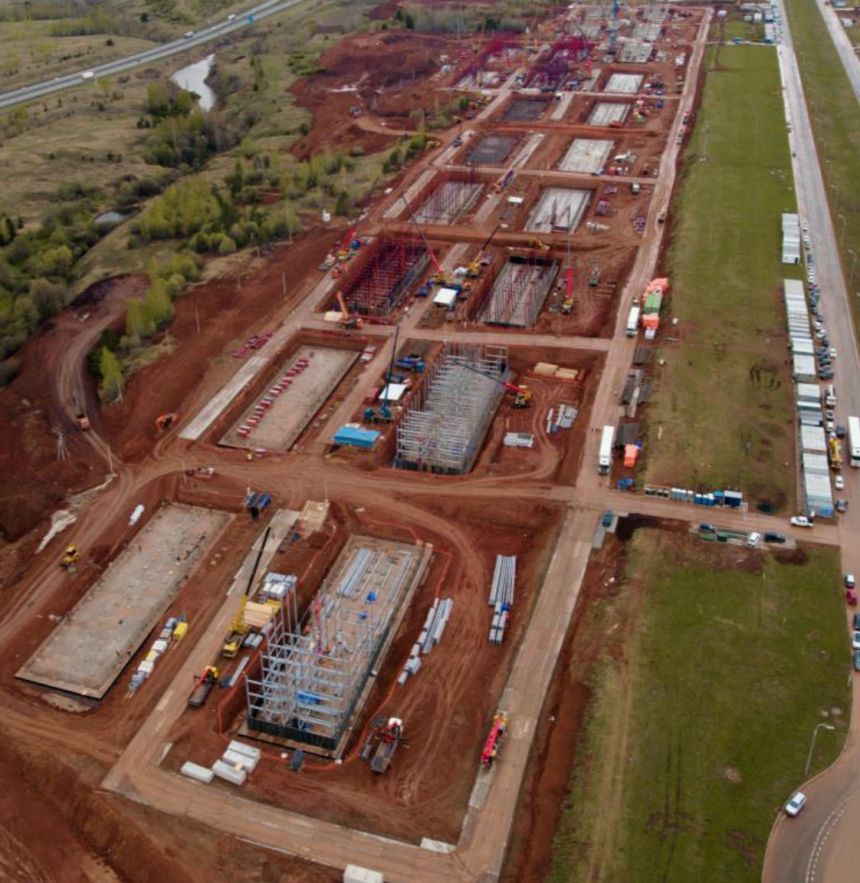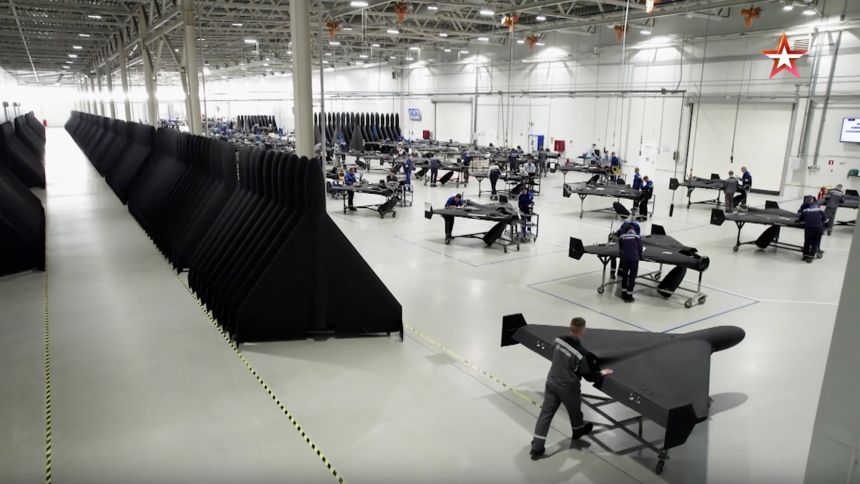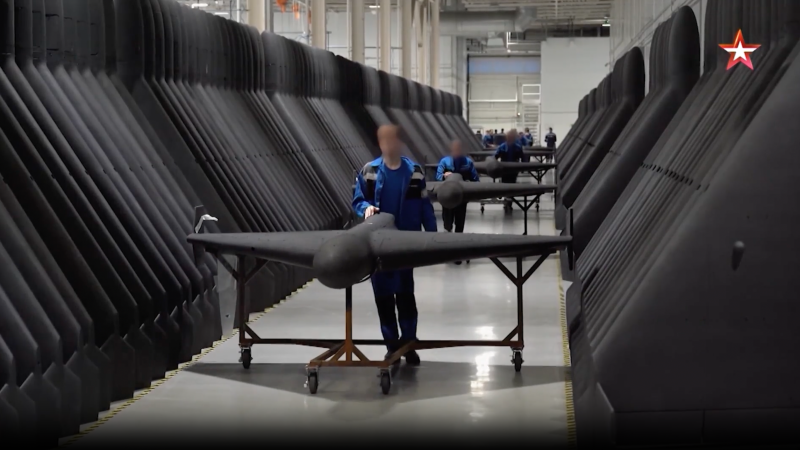“You know, everything you tell us will be used against you,” the interviewer on Russian TV warns Timur Shagivaleev, the man behind one of the country’s biggest drone factories.
Rather than shy away from discussing details of the plant, Shagivaleev replies with a defiant quote that he attributed to a Soviet World War II hero: “You don’t have the right to be afraid.”
Standing at the Alabuga factory amid rows of the distinctive black, triangular Iranian-designed attack drones (known as “Geran” in Russian), he has every reason to feel emboldened.
Satellite imagery shows that construction has sharply accelerated at the site in southern Russia. Dozens of new buildings, including what experts believe to be new dormitories and production facilities, have been rapidly taking shape since the winter snow melted this year.
This is believed to be Russia’s main attack drone factory, a key part of the Kremlin’s escalating drone offensive on Ukrainian cities. To fuel this effort, there’s also now evidence that the site is drafting teenagers, not only into drone assembly at Alabuga but also into construction work.
Moscow has now chosen to publicize the factory and its contribution to Russia’s war effort. Shagivaleev, Alabuga’s director general, appeared on the docuseries “Military Acceptance,” which aired on Russian defense ministry TV channel Zvezda on July 20. This was the first official glimpse inside the production facility.
The program suggests that Alabuga, which has been churning out Iranian-designed Shahed drones for almost three years, has now fully shifted from being an Iranian franchise to a fully localized production line. The expansion is happening so quickly that experts say the site’s end goal may be to mass-produce drones for global export.
David Albright, a former UN weapons inspector, is head of the Institute for Science and International Security (ISIS), a US-based think tank that has been tracking Alabuga’s expansion since 2022.
He told CNN that Moscow’s decision to lift the lid on the factory shows “the Russian authorities are feeling more confident about their ability to make drones.”
“I think it represents that Russia’s government is committed to increases in production there, (and) long-term contracts… (that say) we’ll buy whatever you produce,” he said.
Alabuga began producing Shahed drones in 2023 and it now also churns out cheaper versions designed to act as decoys (known as “Gerbera”).
The site was already expanding as Russian drone attacks on Ukraine started to ramp up last August. Yet recent satellite images reveal even faster growth over the past few months, as drone strikes on Ukraine have hit record numbers.
Between late 2024 and mid-July this year, satellite imagery shows at least eight new warehouse-like structures at Alabuga, close to the buildings previously identified as Shahed manufacturing facilities. Several are still under construction.
Even more strikingly, a CNN analysis of the images and ISIS experts have both identified what appears to be a major expansion in housing for workers at the site.
A July 12 image shows at least 104 identical rectangular buildings either fully or partially built, with a similar footprint to existing structures known to be worker dormitories. In images from February, there were only 15 such buildings. The work on the new buildings appears to have begun in earnest in March, as the spring arrived and the snow disappeared.
There are also signs that construction has accelerated in recent weeks. More than half of the housing unit construction visible on July 12 image was not there on June 9.
Stroytrest Alabuga, the company in charge of construction at the site, removed a section of its website detailing plans for a major housing complex called “Europa hostels” in mid-July, but an internal presentation document published on July 4 appears to show the “second stage” of construction underway. CNN has geolocated the drone visuals included in the presentation to Alabuga.
Albright’s team at ISIS, the US think tank, has assessed that the buildings could accommodate up to 40,000 workers when finished. which he says will represent “a pretty substantial increase in drone production.”
Alabuga’s current production numbers remain a closely held secret. “At one time there was a plan to produce several thousand ‘Gerans,’” Shagivaleev said in the Zvezda interview, without specifying the time period. “Now we produce nine times more than originally planned.”
In December CNN reported that Alabuga had produced more than 5,700 Shahed drones between January and September 2024, over double the number it produced in the whole of 2023. The facility was aiming for 10,000 Gerbera decoy drones in 2024, according to Ukrainian defense intelligence sources.

‘Boys and girls’
Alabuga’s ever-expanding production targets have long presented a staffing problem.
CNN has previously detailed the practice of recruiting teenagers through the Alabuga Polytech college, as well as African women through a foreign outreach scheme, to satisfy a chronic worker shortage in Russia, exacerbated by its war in Ukraine.
Shagivaleev was sanctioned by the US Treasury Department in 2024 in part for his association with “the exploitation of underage students to assemble these UAVs (unmanned aerial vehicles or drones).”
The Zvezda documentary does not gloss over this. The host refers to the “boys and girls” working in the factory, noting “they invite schoolchildren here right after the ninth grade and after college they call them to the plant.” Children in Russia are typically 15 years old when they finish the ninth grade.
There’s now evidence Alabuga is bringing these and perhaps other students not only into assembly work but construction. On July 4, a summer camp called “Alabuga Build” officially opened its doors at the site according to posts on its VKontakte account (or VK, Russia’s version of Facebook).
The tents that the students will be staying in, which were nowhere to be found on satellite imagery from June 9, were on full display as of July 12. CNN counted more than 100 khaki green tents, like the ones seen in the “Alabuga Build” VK posts, next to warehouses associated with drone production.

The camp is organized by the “Russian Student Brigades,” which claims to be the largest youth organization in the country and has drafted in about 2,500 students to build a housing complex called “Mediterranean Park” at Alabuga, according to the education ministry in Russia’s Tatarstan region, where Alabuga is located.
In one of the clips on the camp’s VK page a young man in a khaki jacket gives an ironic tour of his tent, attempting to make a virtue out of the basic conditions. “Here we have a flat screen plasma TV” he says, showing off a basic white cupboard outside a dark green tent with the number “65” on it. “CDs, DVDs, consoles” he continues, picking up pieces of firewood.
The Zvezda documentary suggests Alabuga is now a fully self-sufficient production line.
“Aluminum bars come in, engines are made from them; microelectronics are made from electric chips; fuselages are made from carbon fiber and fiberglass – that is, complete localization,” Shagivaleev boasts in the clip.
“It is precisely such projects that should become the basis of the technological sovereignty of our country so as not to depend on anyone,” added the host.
The images in the program showing Shahed engines being manufactured at Alabuga came as a surprise to several experts whom CNN spoke to.
“The Shahed 136 is powered by the copy of an original German design that the Iranians copied,” said Fabian Hinz, a research fellow at the International Institute for Strategic Studies based in London. “And that was one big question, whether the Russians can now manufacture their own engines, and at least this documentary seems to imply that they can, which… would mean that they’re independent of Iranian components.”
Albright, the former UN weapons inspector, said it seemed manufacturing – rather than just assembly – at the site was advancing. “Our understanding had been that they may assemble the engine at Alabuga, but they were contracting out for the parts that require a foundry. It (now) looks like they may have some furnaces or a small foundry in Alabuga itself.”

Albright said Russia could be planning for Alabuga to not only equip the Russian army, but eventually to sell its drones to foreign customers. This suggests the Zvezda documentary is as much an advert aimed at future buyers, as a program designed to scare Ukrainians.
Other countries are producing their own version of the Shahed, added Hinz, but “Russian ones are up to date when it comes to, for example, electronic counter measures… So I think that would be a huge selling point.”
Kyiv has also openly suggested Russia may have transferred the technology to produce its version of the Shahed to North Korea, part of a rapidly expanding military partnership with Pyongyang.
“The longer this war continues on our territory, the more warfare technologies evolve, and the greater the threat will be to everyone,” Ukrainian President Volodymyr Zelensky warned in June. “This must be addressed now – not when thousands of upgraded ‘“Shahed”, drones and ballistic missiles begin to threaten Seoul and Tokyo.”
CNN has reached out to both Alabuga and the Russian defense ministry to ask about the purpose of expansion at the site, and whether it is transferring the Shahed technology to North Korea. Neither have responded.
Destruction and sleepless nights
In June 2025 alone, Russia fired nearly 5,500 Shahed or similar drones at Ukraine, according to a CNN analysis of Ukrainian air force reports. That’s 16 times more than in June 2024, and a more than 30% increase on the previous month.
On July 9, a record 728 drones were fired at Ukraine in a single night.
Moscow’s escalating air war and the distinctive whine of Shaheds is now forcing Ukrainians out of their beds and into shelters and metro stations on an almost-nightly basis.
“When we stay at home, we always hide behind two walls,” Oleksandr Krupnyk, a father of three in Kyiv, told CNN. “We put our middle child in the bathtub, the youngest on a beanbag chair in the bathroom, and we lay on a mattress in the hallway… with our eldest.”
Krupnyk and his family are committed to staying in the country and doing their part, but he admits Russia’s drone attacks are a near permanent disruption to daily life.
“Constant lack of sleep slows you down, makes you irritable, and reduces your endurance,” he explained, adding that his children are struggling with their studies and beg not to go to school.
Zelensky said on Tuesday that: “Putin is off the deep end with this ‘Shahed’ obsession and terror.”
The president added that Ukraine was not just pushing for more air defenses from its allies but it would also continue with its own deep strikes on Russian territory, at least three of which have targeted Alabuga, a site with an ever-growing role in this conflict.

